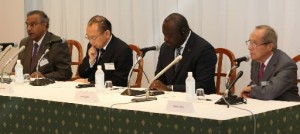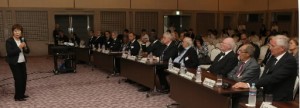Meeting of “Group of Eminent Persons” closes after adopting Hiroshima Declaration
Sep. 14, 2015
by Kyosuke Mizukawa, Staff Writer
The Group of Eminent Persons (GEM) adopted the Hiroshima Declaration, which calls for the early entry into force of the Comprehensive Nuclear-Test-Ban Treaty (CTBT), prior to the conclusion of their gathering on August 25. At the meeting held in Hiroshima, the GEM, part of the Preparatory Commission for the CTBT Organization, stated that the current prohibition against nuclear test explosions “remains at risk every day.” The group called for “a multilateral approach” to encourage the leadership of the eight states that have not ratified the treaty to facilitate their ratification process. The two-day meeting was the first such meeting held in Japan.
Representing the participants, four members held a press conference at the hotel where the meeting was held. Jayantha Dhanapala from Sri Lanka, the former United Nations Under-Secretary-General for Disarmament Affairs, read out the declaration, which consists of an introduction and eight points. For the CTBT to enter into force, it must be ratified by so-called Annex 2 states, of which eight states, including the United States and China, have not ratified it. The declaration urges those eight countries to “urgently sign and ratify the treaty, without waiting for other states to do so.” The declaration also states that the group will make “focused efforts” for the effectuation of the treaty in cooperation with Japan and Kazakhstan, which will serve as co-chairs of the Conference on Facilitating the Entry into Force of the CTBT, scheduled for September in New York.
The declaration stresses that the CTBT is vital for preventing the catastrophic human consequences of a nuclear attack. It also touches on the “importance of maintaining the existing moratoria on nuclear test explosions” and called upon North Korea to refrain from conducting any further nuclear tests.
Summarizing the meeting, Lassina Zerbo, the executive secretary of the Preparatory Commission, said that, moved by the call of atomic bomb survivors for the abolition of nuclear weapons, the group reaffirmed the necessity of the early effectuation of the CTBT. Citing the example of the nuclear deal reached with Iran in July, he pointed to the importance of multinational cooperation and said the declaration should be put into action rather than ending up as simply a written statement.
The GEM was launched in September 2013. This was their fourth meeting. Ten out of its 21 members attended the meeting, including William Perry, the former U.S. secretary of defense; Des Browne, the former U.K. secretary of state for defense; and Michel Duclos, the former head of disarmament at the Ministry of Foreign Affairs of France.
Summary of the Hiroshima Declaration
・The entry into force of the CTBT is one of the most essential and practical measures for nuclear disarmament and non-proliferation. Bringing the CTBT into force is a global responsibility.
・The GEM is mindful that the victims of Hiroshima and Nagasaki call for world leaders to visit their cities.
・The GEM is committed to making focused efforts to achieve the CTBT’s entry into force in a coordinated and concerted manner with co-chairs of the Conference on Facilitating the Entry into Force of the CTBT.
・The GEM encourages the eight states that have not ratified the CTBT to sign and ratify it. The declaration also calls for a multilateral approach to engage the leadership of the eight states.
・The GEM calls on North Korea to refrain from conducting any further nuclear tests.
by Kyosuke Mizukawa, Staff Writer
Ten members of the Group of Eminent Persons of the Preparatory Commission for the Comprehensive Nuclear-Test-Ban Treaty Organization visited Hiroshima Peace Memorial Park on August 25. They toured the Peace Memorial Museum and listened to the account of an A-bomb survivor.
Guided by Yasuyoshi Komizo, the chairperson of the Hiroshima Peace Culture Foundation, they stopped in front of a model of the city center in the aftermath of the atomic bombing and a charred lunchbox carried by one of the victims. They nodded as Mr. Komizo explained the exhibits and focused cameras on the items on display.
At the International Conference Center Hiroshima, they listened to Keiko Ogura, 78, share her A-bomb experience in English and wrote down their impressions on paper provided by the city government. William Perry, the former secretary of defense of the United States, a nuclear power, wrote, “We must all work to insure that nuclear weapons are never, ever, used again!” Then he moved to Ms. Ogura and thanked her.
Des Browne, the former U.K. secretary of state for defense, wrote, “I am reinforced in my commitment to a world free of nuclear weapons.” Lassina Zerbo, the executive secretary of the Preparatory Commission, wrote, “Never again Hiroshima.” Other members also wrote about the importance of facing the inhumanity of nuclear weapons and their wish for peace. Ms. Ogura commented, “These people who have political influence listened to me very seriously. I hope they will help break the status quo, where there is little progress being made for the elimination of nuclear weapons.”
The planned flower offering at the Cenotaph for the A-bomb Victims was canceled due to a typhoon.
(Originally published on August 26, 2015)
The Group of Eminent Persons (GEM) adopted the Hiroshima Declaration, which calls for the early entry into force of the Comprehensive Nuclear-Test-Ban Treaty (CTBT), prior to the conclusion of their gathering on August 25. At the meeting held in Hiroshima, the GEM, part of the Preparatory Commission for the CTBT Organization, stated that the current prohibition against nuclear test explosions “remains at risk every day.” The group called for “a multilateral approach” to encourage the leadership of the eight states that have not ratified the treaty to facilitate their ratification process. The two-day meeting was the first such meeting held in Japan.
Representing the participants, four members held a press conference at the hotel where the meeting was held. Jayantha Dhanapala from Sri Lanka, the former United Nations Under-Secretary-General for Disarmament Affairs, read out the declaration, which consists of an introduction and eight points. For the CTBT to enter into force, it must be ratified by so-called Annex 2 states, of which eight states, including the United States and China, have not ratified it. The declaration urges those eight countries to “urgently sign and ratify the treaty, without waiting for other states to do so.” The declaration also states that the group will make “focused efforts” for the effectuation of the treaty in cooperation with Japan and Kazakhstan, which will serve as co-chairs of the Conference on Facilitating the Entry into Force of the CTBT, scheduled for September in New York.
The declaration stresses that the CTBT is vital for preventing the catastrophic human consequences of a nuclear attack. It also touches on the “importance of maintaining the existing moratoria on nuclear test explosions” and called upon North Korea to refrain from conducting any further nuclear tests.
Summarizing the meeting, Lassina Zerbo, the executive secretary of the Preparatory Commission, said that, moved by the call of atomic bomb survivors for the abolition of nuclear weapons, the group reaffirmed the necessity of the early effectuation of the CTBT. Citing the example of the nuclear deal reached with Iran in July, he pointed to the importance of multinational cooperation and said the declaration should be put into action rather than ending up as simply a written statement.
The GEM was launched in September 2013. This was their fourth meeting. Ten out of its 21 members attended the meeting, including William Perry, the former U.S. secretary of defense; Des Browne, the former U.K. secretary of state for defense; and Michel Duclos, the former head of disarmament at the Ministry of Foreign Affairs of France.
Summary of the Hiroshima Declaration
・The entry into force of the CTBT is one of the most essential and practical measures for nuclear disarmament and non-proliferation. Bringing the CTBT into force is a global responsibility.
・The GEM is mindful that the victims of Hiroshima and Nagasaki call for world leaders to visit their cities.
・The GEM is committed to making focused efforts to achieve the CTBT’s entry into force in a coordinated and concerted manner with co-chairs of the Conference on Facilitating the Entry into Force of the CTBT.
・The GEM encourages the eight states that have not ratified the CTBT to sign and ratify it. The declaration also calls for a multilateral approach to engage the leadership of the eight states.
・The GEM calls on North Korea to refrain from conducting any further nuclear tests.
Members of Group of Eminent Persons visit Peace Memorial Park
by Kyosuke Mizukawa, Staff Writer
Ten members of the Group of Eminent Persons of the Preparatory Commission for the Comprehensive Nuclear-Test-Ban Treaty Organization visited Hiroshima Peace Memorial Park on August 25. They toured the Peace Memorial Museum and listened to the account of an A-bomb survivor.
Guided by Yasuyoshi Komizo, the chairperson of the Hiroshima Peace Culture Foundation, they stopped in front of a model of the city center in the aftermath of the atomic bombing and a charred lunchbox carried by one of the victims. They nodded as Mr. Komizo explained the exhibits and focused cameras on the items on display.
At the International Conference Center Hiroshima, they listened to Keiko Ogura, 78, share her A-bomb experience in English and wrote down their impressions on paper provided by the city government. William Perry, the former secretary of defense of the United States, a nuclear power, wrote, “We must all work to insure that nuclear weapons are never, ever, used again!” Then he moved to Ms. Ogura and thanked her.
Des Browne, the former U.K. secretary of state for defense, wrote, “I am reinforced in my commitment to a world free of nuclear weapons.” Lassina Zerbo, the executive secretary of the Preparatory Commission, wrote, “Never again Hiroshima.” Other members also wrote about the importance of facing the inhumanity of nuclear weapons and their wish for peace. Ms. Ogura commented, “These people who have political influence listened to me very seriously. I hope they will help break the status quo, where there is little progress being made for the elimination of nuclear weapons.”
The planned flower offering at the Cenotaph for the A-bomb Victims was canceled due to a typhoon.
(Originally published on August 26, 2015)









